Giant hogweed identification guide
Read through our Giant Hogweed identification guide below. If you are still not sure, email us your photos and we’ll confirm whether it’s Giant Hogweed for FREE
Quick facts
- Giant hogweed has blotchy purple marks on the stems.
- Giant hogweed can grow 3-5m tall.
- Flowers from mid-June to end of July.
- The sap of Giant hogweed is TOXIC.
- The seeds of Giant hogweed can remain viable for up to 15 years.
Quick Links




What is Giant hogweed?
Giant hogweed (Heraculum mantegazzianum), native to South-East Asia in the Caucasus region, was imported to the UK as an ornamental garden plant in Victorian times. Since then, it has escaped from intentionally planted areas into the countryside.
Giant hogweed is a member of the carrot family and shares many characteristics with its family members. But this species of hogweed really is a giant by comparison!
There are also other notable invasive species in the same group that cause problems in the UK, notably;
- Heracleum persicum (Persian hogweed).
- Heracleum sosnowskyi (Sosnowski’s hogweed).
Giant hogweed identification
Giant hogweed, unlike our native common hogweed, is a very large plant which can grow up to 5m tall. It has hundreds of individual small white flowers in summer, these are arranged in umbrella shaped flower-heads (umbels) and can produce between 20-50,000 of seeds each year.
Giant hogweed is a perennial plant, this means that the above ground growth dies back in the winter and re-emerges the following spring. The leaves become grey and all but disappear, leaving a rosette of dead leaves. However, if conditions allow, Giant hogweed stems and dead umbel flower heads will remain visible above ground.
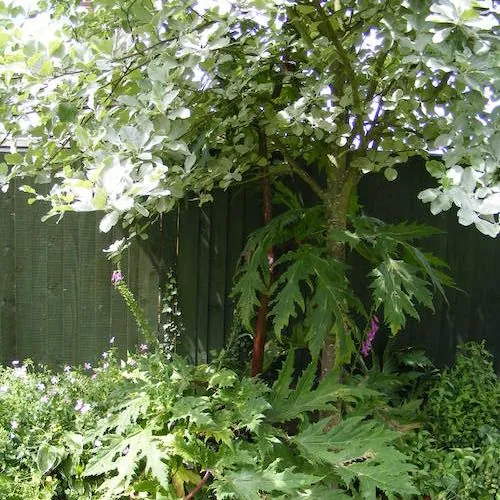
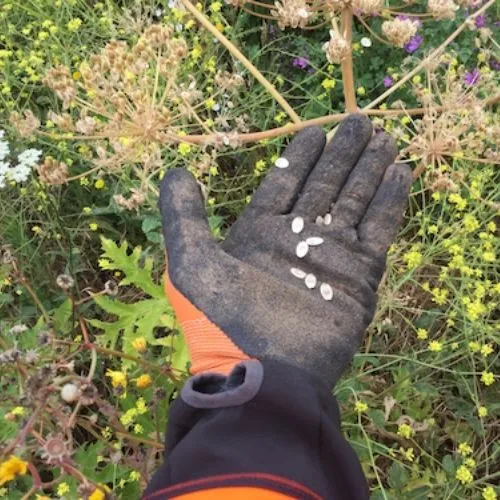
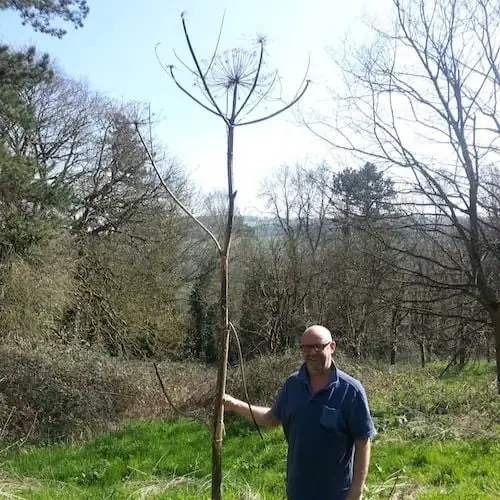
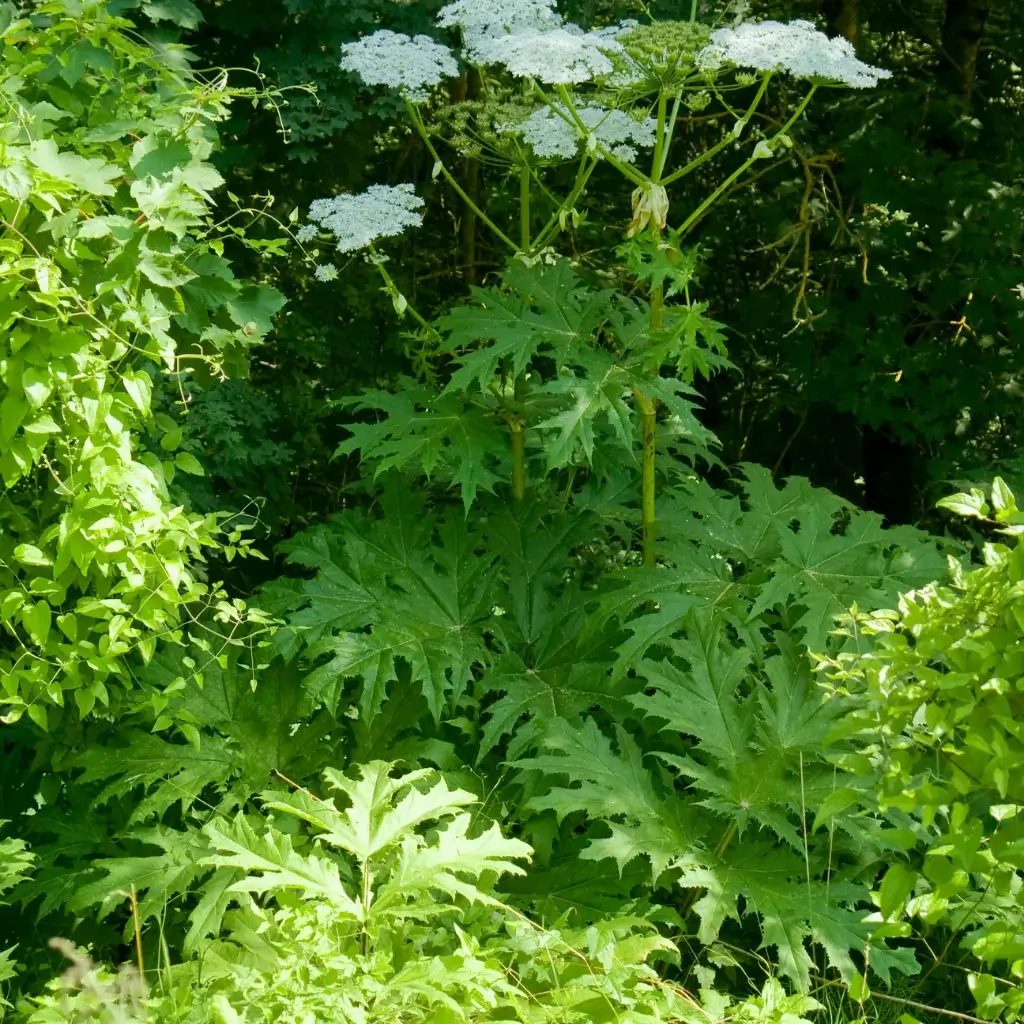
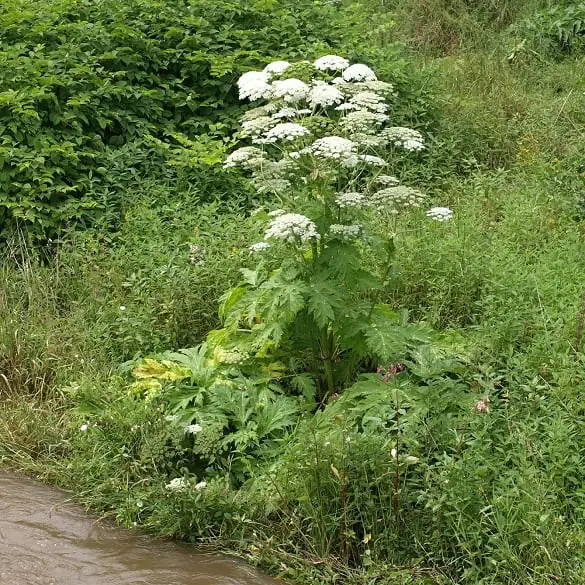
Giant hogweed leaves: what do they look like?
Giant hogweed leaves are usually dark green and are spiky in appearance, they grow in a rosette formation similar to dandelions. Before it blooms in early summer, each Giant hogweed leaf can grow to 1.5m in diameter. Giant hogweed leaves look similar to common Hogweed and Cow Parsnip leaves.
Giant hogweed stems: what do they look like?
The stems of Giant hogweed support the flower heads and are green with purple or dark red blotches, these blotches are not seen on other mimicking plants. The stems also have visible white bristles along the length, which get thicker towards the base of the plant. Fully grown stems can be 10cm across and are hollow.
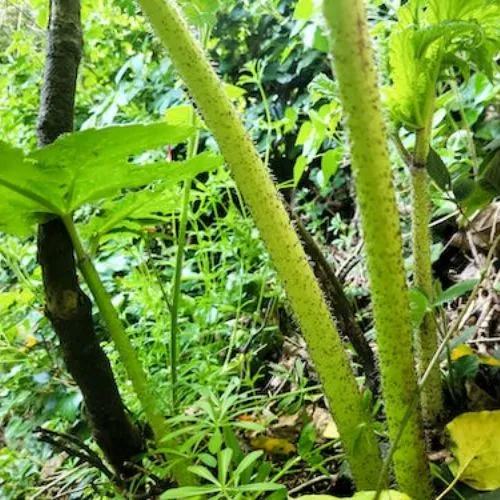
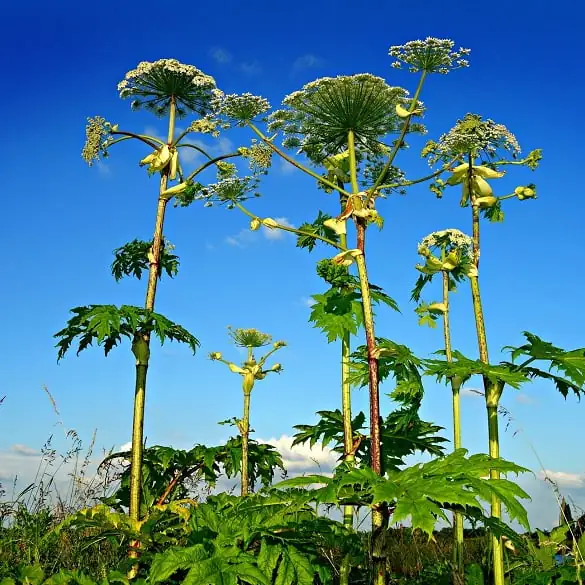
WE CAN HELP YOU REMOVE Giant hogweed
Have you got a Giant hogweed problem?
Giant hogweed flowers: what do they look like?
Giant hogweed flowers do not develop until the plants are mature (at around 3 years). But when they grow, they stretch high into the sky, reaching 5m above ground level in optimum conditions – the same height as an adult giraffe! Small white flowers form in clusters on umbrella shaped flower heads that can be 50 centimetres in diameter.
There are lots of plants in the UK that share the same flower head shape and are sometimes confused with Giant hogweed, including:
- wild carrot
- cow parsley
- sweet cicely
- common hogweed
- wild angelica
- alexanders
- sweet cicely
- water hemlock
- wild parsnip
- hemlock
But the incredible size of Giant hogweed plants means that it will not take you long to recognise if Giant hogweed starts to grow in your garden.


Where does Giant hogweed grow?
In its native range, nutrient poor soils and a cold climate meant that Giant hogweed developed a multi-thousand seed growth strategy. As an alien species in the UK and Ireland where the climate is warmer, and soils are richer this strategy has meant that more seeds remain viable, and the plant grows far more easily. This has resulted in exponential growth of the species over the last 150 years.
Originally confined to large ornamental gardens and country estates, Giant hogweed is now most commonly found:
- Along riverbanks, where seeds are transported in the water.
- In gardens and allotments found close to infested woodlands/heathlands.
- In undisturbed wasteland.
Giant Hogweed Locations
Various maps of Giant Hogweed distribution have been created in the past, and generally show it to be widespread across the UK and Northern Ireland. The West of Wales and South West England seem to be least affected. Giant Hogweed Hotspots include North London, Greater Manchester, and the East Coast of Scotland. The truth is that Giant Hogweed can be found in most locations in the UK.
Reporting Giant Hogweed Sightings
Although it is not illegal to grow Giant Hogweed, or to let it grow on private land, because Giant Hogweed is so dangerous, we recommend that any sightings are reported to the landowner or relevant local authority if it is an accessible location such as a park, on a footpath or in a built-up area.
The giant hogweed plants can then be safely destroyed and the area monitored for future growth.
What is Giant hogweed commonly mistaken with?
There are multiple plants found around England and Wales that are commonly mistaken for Giant Hogweed. These include:

Cow Parsnip
Heracleum lanatum
- Softer edged leaves.
- Flatter flower head.
- No purple splotches on stem.
- 2-3m tall.

Common Hogweed
Heracleum sphondylium
- Smaller (up to 2m).
- Softer edged leaves.
- No purple splotches, but their colour graduates smoothly from green to purple.

Cow Parsley
Anthriscus sylvestris
- Not a true Hogweed, part of the carrot/parsnip family.
- Different leaf pattern (tripinnate).
- Native to the UK.
Giant hogweed burns & blisters
Giant hogweed is probably one of the most well know invasive plants that grows in the UK, because of the shocking skin burns and blisters that occur when people get the sap on their skin. Giant hogweed sap contains furocoumarin, a chemical which causes chemical burns to the skin and can cause:
- Rashes.
- Blisters.
- Burns.
- Blindness.
- Sun sensitivity.
Mild exposure to Giant hogweed will likely result in a rash similar in appearance to a nettle sting. Red, raised blotches that are itchy and painful to touch are common symptoms.
In more serious cases a Giant hogweed rash will turn into blisters. These can be large and extremely painful, and you will need to seek medical advice by speaking with your GP, calling the NHS helpline, or in cases where a large area of your body is affected, you may need to go to A&E, just like you would for a burn caused by heat.
The skin damage and blisters can take a long time to heal and resulting skin sensitivity can take years to heal. In severe cases, phytophotodermatitis can occur. This causes light-reactive blisters on the skin which can re-form when the affected skin is exposed to sunlight.
If the sap gets into your eyes, it can cause scarring, and ultimately sight loss.


What to do if you touch Giant hogweed?
Contact with Giant hogweed should be avoided at all costs. If you accidentally get giant hogweed sap on your skin, you should:
- Cover the area straight away.
- Thoroughly wash the affected area with COLD water and soap.
- Keep exposed area away from any sunlight for at least 48 hours.
- If any blistering starts, seek medical help – blisters may appear immediately after you come in contact with the sap but also up to 48 hours after.
- If any sap gets into your eyes, then wash straight away, cover eyes with eye pads or sunglasses and seek immediate medical help.
The harmful elements of Giant hogweed are a large reason why removal is recommended to take place in the spring, prior to flowering and large stem growth.
Giant hogweed: dogs and other animals
Giant hogweed is also very harmful to dogs and any other animals like horses that might come into contact with the plant. The sap of Giant hogweed can cause skin rashes, blisters, and even blindness in animals, just like it does in humans. Although pets often have some protection from their fur, hairless or thin furred areas (such as the ears, mouth, eyes, nose and belly) can be affected.
If the hogweed sap is licked off the coat or gets into the eyes, it can cause even more damage. It only takes a small amount of sap to damage your pet’s fragile skin.
If you are walking your dog and spot giant hogweed, you should put them on the lead and keep well clear of the area to ensure your four-legged friend does not brush up against it. If you think your dog may have come into contact with Giant hogweed or are concerned at all about their health following a walk, seek immediate veterinary attention.


Is Giant hogweed poisonous?
In short, yes, Giant hogweed should be considered poisonous, especially when raw. The toxic sap of the plant will cause severe irritation, burning and blistering of the skin cells. Even the smallest amount of the toxic sap is enough to cause discomfort.
The UK’s native common hogweed is not however poisonous, and some people still forage for parts of the plant such as the hogweed buds, seeds and young hogweed leaves.
If you are planning to eat hogweed, we recommend you really know what you are doing before you embark on a foraging trip, as although edible, common hogweed has been known to cause allergic reactions in some people. Furthermore, there are lots of plants such as giant hogweed and hemlock that are similar in appearance to common hogweed. The consequences of picking or eating the wrong plant are extremely dangerous.
Start fixing your invasive plant problem today by requesting a survey
Request a survey
Rest assured, where invasive species are identified at an early stage and tackled correctly, problems can usually be avoided. Our specialist consultants complete thorough surveys to identify the extent of the problem. Our plans aren’t one-size-fits-all; they’re customised to tackle the invasive species at your property effectively, taking account of all of your requirements.
What our clients say
Reviews
Environet have been excellent
by Rosaline Barrett
Environet have been excellent for the initial survey to removal of bamboo . Highly professional from start to finish can highly recommend them
Running bamboo removal works
by Kim Barnes
“I would definitely recommend Environet as a company, from my recent dealings with them. The work undertaken was the removal of running bamboo from our back garden, that we rather naïvely planted 20 years ago and which had run amok meanwhile, towards the house. All dealings with the Environet team, from the initial assessment to the admin team, to the lads that turned up on the day, were smooth, professional and efficient. Emails were concise and explanatory, and responses to my queries were immediate. The lads who did the physical work slogged away over two days in appalling weather conditions (wind, rain, cold) but could be heard laughing and joking while they worked. I was kept informed at all stages and when the job was finished, they tidied up very nicely. Five stars well deserved all round.”
These guys get the job done…
by Ms Brown
“These guys get the job done professionally & efficiently and there’s no stress for the client. I can’t recommend them highly enough. It’s not a cheap process getting rid of bamboo but The Environet team do a great job.”
Removing a 25 year old Bamboo clump no mean feat.
by Russ Pariss
“The guys managed to remove a 25 year old clump of bamboo from my garden and all the runners from my neighbours garden. They were very efficient and completed the job in less time than I anticipated. I was expecting there to be only two guys but in fact there were four. Well done and thank you.”
Professional and knowledgeable
by Susan
“From the start of the work (the initial quote) to the end (the removal of an entire bamboo screen growing within a couple of metres of my house), I found great reassurance with Environet. I know it’s important to have bamboo removed responsibly (and completely) so I went to the experts, and they didn’t let me down. They explained everything to me, and advised me on best steps forward. After a growth spurt in the bamboo over the summer (to about 15′ high), they came and removed it all, including roots and rhizomes (with minimal disruption). I feel comfortable knowing this job has been done properly. They are very professional and knowledgeable.”
GET IN TOUCH
Contact us
Our team of experts is available between 9am and 5:30pm, Monday to Friday to answer your enquiries and advise you on the next steps
Want a survey?
If you already know you have an invasive plant problem, you can request a survey online in less than two minutes by providing a few brief details. A member of the team will swiftly come back to you with further information and our availability.
Need quick plant identification?
Simply upload a few images of your problem plant to our identification form and one of our invasive plant experts will take a look and let you know, free of charge what you are dealing with. We’ll also be there to help with next steps where necessary.



